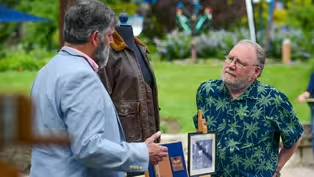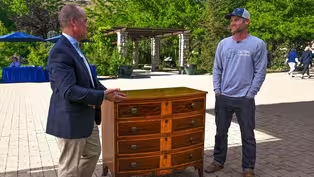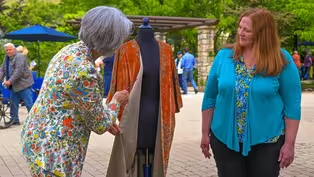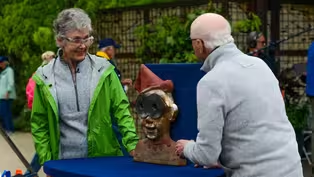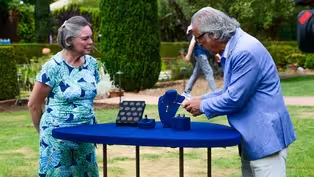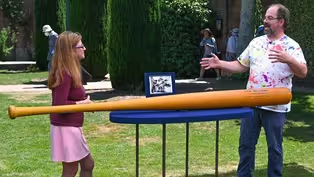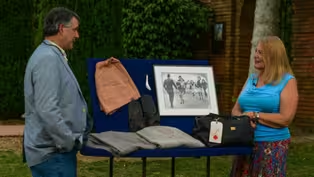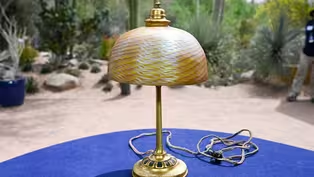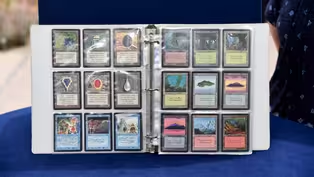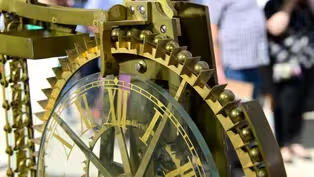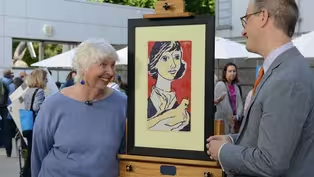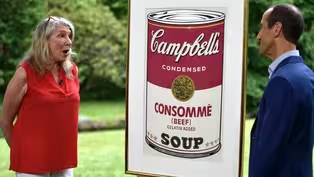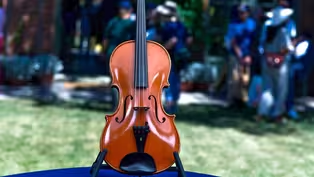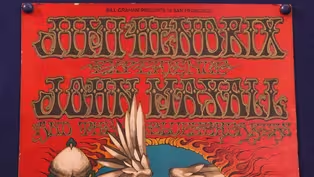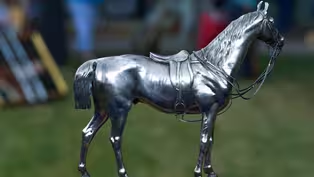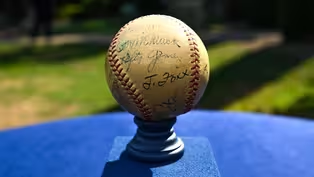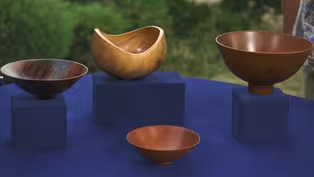
RECUT: Filoli, Part 1
Special | 22m 30sVideo has Closed Captions
This season's first half-hour of RECUT wows our guests with a $200,000 to $330,000 find!
This season's first half-hour of RECUT wows guests with treasures that include a 1976 Apple-I operation manual mock-up for Apple-II, a 1934 All Americans team-signed baseball, and a 1967 Ansaldo Poggi viola. One is $200,000 to $330,000!
Problems playing video? | Closed Captioning Feedback
Problems playing video? | Closed Captioning Feedback
Funding for ANTIQUES ROADSHOW is provided by Ancestry and American Cruise Lines. Additional funding is provided by public television viewers.

RECUT: Filoli, Part 1
Special | 22m 30sVideo has Closed Captions
This season's first half-hour of RECUT wows guests with treasures that include a 1976 Apple-I operation manual mock-up for Apple-II, a 1934 All Americans team-signed baseball, and a 1967 Ansaldo Poggi viola. One is $200,000 to $330,000!
Problems playing video? | Closed Captioning Feedback
How to Watch Antiques Roadshow
Antiques Roadshow is available to stream on pbs.org and the free PBS App, available on iPhone, Apple TV, Android TV, Android smartphones, Amazon Fire TV, Amazon Fire Tablet, Roku, Samsung Smart TV, and Vizio.
Buy Now
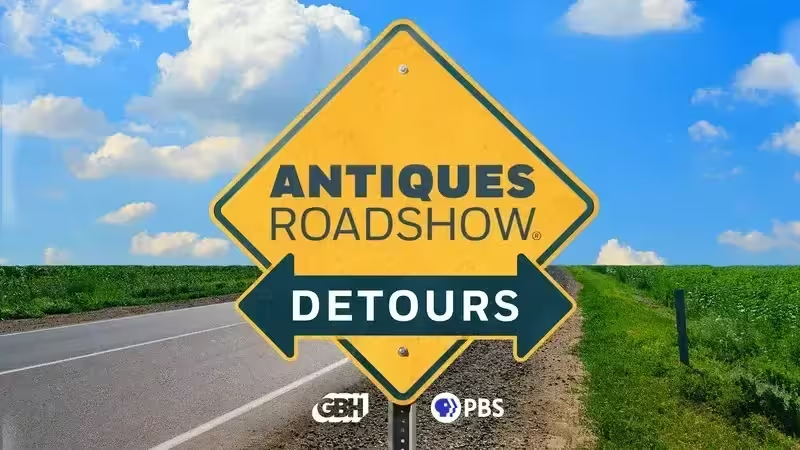
ANTIQUES ROADSHOW DETOURS
Ever wondered what happens to the treasures featured on America’s beloved ANTIQUES ROADSHOW after the cameras leave town? Host Adam Monahan tracks down the juicy afterlives of your favorite finds from PBS’s hit series.Providing Support for PBS.org
Learn Moreabout PBS online sponsorshipMore from This Collection
America’s favorite treasure hunt ANTIQUES ROADSHOW presents a bite-sized way to enjoy the show. ANTIQUES ROADSHOW RECUT features thirty-minute episodes, packed full of favorite finds and paced for maximum entertainment. RECUT features episodes recut from the show’s previous visits to distinctive and historic locations across the country.
RECUT: Idaho Botanical Garden, Part 4
Video has Closed Captions
Wrap up Season 4 of RECUT with a $50,000 appraisal at Idaho Botanical Garden! (22m 31s)
RECUT: Idaho Botanical Garden, Part 3
Video has Closed Captions
Visit the “City of Trees” for unbe-leaf-able Boise treasures in this half-hour RECUT. (22m 31s)
RECUT: Idaho Botanical Garden, Part 2
Video has Closed Captions
In this half-hour RECUT, watch breathtaking Boise appraisals at Idaho Botanical Garden. (22m 31s)
RECUT: Idaho Botanical Garden, Part 1
Video has Closed Captions
Gem State treasures sparkle in this half-hour RECUT at Idaho Botanical Garden! (22m 31s)
Video has Closed Captions
Watch wow-worthy Woodside finds in this half-hour RECUT and learn which is up to $44,000! (22m 24s)
Video has Closed Captions
In this half-hour RECUT episode, golden state treasures shine at Filoli. One is $150,000! (22m 23s)
Video has Closed Captions
Watch fascinating Filoli finds in this half-hour RECUT, including one up to $100,000! (22m 36s)
RECUT: Desert Botanical Garden, Part 2
Video has Closed Captions
Phoenix treasures heat up, like one appraisal up to $35,000, in this half-hour RECUT! (22m 28s)
RECUT: Desert Botanical Garden, Part 1
Video has Closed Captions
Phenomenal Phoenix finds abound in this half-hour RECUT. One is worth up to $100,000! (22m 26s)
RECUT: Crocker Art Museum, Part 2
Video has Closed Captions
See stunning Sacramento finds like one $80,000-$125,000 treasure, in this half-hour RECUT! (22m 28s)
RECUT: Crocker Art Museum, Part 1
Video has Closed Captions
Head to California’s Crocker Art Museum for a bite-sized RECUT! One find is up to $75,000! (22m 27s)
RECUT: Winterthur Museum, Garden & Library, Part 2
Video has Closed Captions
Discover Delaware treasures in this half-hour RECUT, including one valued at $50,000! (22m 27s)
Providing Support for PBS.org
Learn Moreabout PBS online sponsorship♪ ♪ CORAL PEÑA: The surprises are bountiful at Filoli, in Woodside, California.
GUEST: I got it dumpster diving.
(laughing): You know, I hate to say it, but it's true.
D'oh!
(chuckles): Okay.
Wow.
That's surprising.
PEÑA: It's "Antiques Roadshow Recut."
♪ ♪ PEÑA: In this episode of "Antiques Roadshow Recut," we're at Filoli in Woodside, California.
Located in the Santa Cruz Mountains, this historic property was once the home of the prominent Bourn family.
William Bourn, whose wealth came from the Empire gold mine and investments in California utility companies, was the one who named the estate, combining the first letters of his personal motto, "Fight, love, live," to create "Filoli."
The house was finished in 1917, and 16 acres of incredible formal gardens were completed in 1929.
Among the flowers today: "Roadshow" attendees eager to find out more about their items.
Take a look!
♪ ♪ I brought a original Apple I computer manual.
(chuckles): One day I was at work, and I worked at Apple, and the, uh, facilities crew was cleaning out some closets, and they had a great big old dumpster, so I got it dumpster-diving.
(laughing): That's what...
I mean, I hate to say it, but it's true.
D'oh!
That is awesome!
And that was in about 1987?
How long did you work at Apple?
33 years.
And it was like 33 years that went in the blink of an eye.
Every day was different.
You never knew who you were going to see.
It was just an incredibly fantastic, enlightening time.
There is no way to express how important the Apple I computer is.
The first big debut was in 1976 at the Homebrew Computer Club in Palo Alto.
Yep.
Yep, yep.
It carried a retail cost of $666.66, which, originally, you'd be, like, "Wow, 666."
Whoa!
"That might not..." (laughter) "That might not be the greatest number to market."
But the reason why is, uh, Steve Wozniak loved, like, the soothing feeling of hearing repeated numbers.
So they came up with $666.66, which is equivalent to a little bit over $3,000 in today's market, if you account for inflation.
Mm-hmm.
So this is a huge chunk of change back in the '70s.
Now get to the manual.
We have the original Apple logo on the front, with Isaac Newton sitting under the apple tree.
This logo was designed by Apple's third co-founder, Ronald Wayne.
Shortly after founding the company with Steve Jobs and Steve Wozniak, he ended up selling out of his shares for $800.
(laughing): Wow.
Now, why are we seeing this manual mocked up?
This manual was actually the marketing comp, and there were all kinds of marks on it, like white-out, because they were going to be changing the Apple I operation manual tag to, like, the next-generation computer.
You can see Apple preparing to change their logo from that Sir Isaac Newton to, now, you have the Apple lo... You have the updated address, you have the updated year.
Yep, yep.
They were mocking this up to get ready... Yep.
...for the Apple II in '77.
So, this is, like, my crazy mind of thinking just imagine whose hands were making those changes to say, you know, "Oh, we gotta change this logo.
We gotta change this wording."
Even when you go to the back of the book, it's so cool seeing the mark-up "Replace with new art."
The other thing is the historical significance of, this is a mock-up copy.
So when it comes to putting a value on it, conservatively, at auction today, the pamphlet would be estimated $10,000 to $15,000.
That is more than surprising, and more than I ever would have thought, I mean, even if you told me ten bucks, it would've been okay.
(laughs) (laughing): I mean, seriously.
That is beyond my wildest expectation.
Yeah, the chair was purchased by his great-grandparents at the Rudolph Valentino estate auction.
So, we are going to send you to the furniture table.
Okay.
APPRAISER: Hi!
Come on over.
So what do you know about the chairs?
Most of the furniture in the Lair, which was Rudolph Valentino's estate, was of a similar type, very sort of ornate.
I just love the faces on the arms and the teeth like this.
Isn't it cool?
What a fabulous chair, and these beautiful birds.
What you have here is a Savonarola chair, and this is better than most.
So, if this were to come to auction, I would probably put an estimate of $500 to $1,000 on it.
But the value is in the Valentino story, I think.
Hm, hm.
Okay.
There's a colleague we have in our collectibles department by the name of Laura Woolley, who can talk about value relative to Valentino.
GUEST: So this chair was purchased at, uh, Rudolph Valentino's estate... 1926.
Yes, yes.
(others laugh) There were two of them originally.
We still have the two.
What did Andrew say?
He thought it was fabulous.
He thought it was maybe $1,000 or so, um, but he said the value is in Rudolph Valentino.
Andrew is so smart.
(chuckles) Yeah.
It is.
So he said, "Go to Laura, because she knows."
It is, and I have that catalog at home.
So... Yeah.
They, they even sold his greyhound dog in that auction catalog.
(men exclaim and laugh) They sold off everything he owned.
Did they state in the catalog if this is from Falcon Lair?
It is.
Yeah.
Yes, yeah.
There you go.
So, Falcon Lair is the, his famous home... Yeah.
...that sadly no longer exists.
Yep.
It was torn down.
And when you want a Valentino piece, you want a Valentino piece that looks like it came out of Valentino's house.
Yeah.
And this does.
(laughs) So this is really exciting.
And then you tell me you have two.
Yeah, there's two.
Ah.
Well, a number of pieces that have sold in that original auction catalog have come back up.
Okay.
And they do quite well, 'cause he's one of the few silent characters that people still know.
Yeah.
His name i, will live forever.
Yep.
He died at such a young age, tragically.
Yeah, yeah.
Um, and a chair like this, easily I can see $10,000 to $12,000 at auction.
Great.
Okay.
Per chair.
Per chair?
Yeah.
Okay, wow.
If you were going to insure it, I'd probably put at least $15,000 apiece on them.
All right, thank you.
Thank you.
That's exciting.
Thank you, yeah.
So you've got $30,000 worth of chairs to sit in.
(all laughing) Yeah, yeah.
GUEST: I inherited these bowls from a very, very dear friend of mine.
APPRAISER: Mm-hmm.
She was an artist and an art teacher.
Mm-hmm.
And she passed away about ten years ago.
They're beautiful.
I sit them in the nooks of my bookcases.
(laughs) Yeah.
And do you know who made them?
These bowls were made by a local artist named Bob Stocksdale.
And my understanding is he had a studio right here in the area, on Kings Mountain.
My friend who left them to me used to visit him and hang out with him.
Yeah.
And over the years purchased various bowls that he made.
I think that Bob Stocksdale is certainly one of the most well-known woodturners in America.
He was one of the first guys to start.
He, he took the whole art form to another, another level.
He really has made a big difference, and some of his turned bowls are amongst the best that anyone has ever done.
Wow.
When I saw you, uh, un, unveil them on my table, I thought, "Oh, my God, those are Bob Stocksdale, and they're so fantastic!"
(chuckles) You recognized them?
I did.
Bob Stocksdale w, was a really interesting man.
One: he was a conscientious objector during World War II, which was very unusual in America.
He spent time in various prison camps in America.
He ended up moving here, California... Mm-hmm.
...and, and began making bowls after the war.
He made about 200 a year.
He dies in 2003, but, but that's a lot of bowls.
Made about 8,000 bowls.
Hm.
And one of the things he's most well-known for is using really cool, exotic wood.
And, and if you look at the four that you have... Mm-hmm.
...they're all different, they're all interesting.
Yes.
And people would send him wood from around the world, and he would make them a bowl out of it.
That's funny.
Because he was a local artist, I assumed these, at least most of them, would be local wood.
These are woods that are beyond my...
Okay, so... ...common furniture knowledge...
Right.
...to be honest.
The ebony I recognize.
Right.
But the rest of them are not something that you see every day.
Okay.
These were produced in the '90s, which is sort of the middle of his career.
Mm-hmm.
Kind of tailing off a little bit, but was still, he was very active at this point.
People collect them but it's not something that's really taken off yet, and it's still moving forward.
But one of the things I did see was this one has been cracked.
(gasps): No!
And it has cracks in several different places, and that's going to really affect the value.
And I think his work is as good and as beautiful, and, and actually tells the tale of woodturning in America as well as anybody.
Do you have any idea what these pieces are worth?
I have no idea at all.
(laughs) Yeah-- do you have any idea?
You're going to make a guess?
Um... Maybe a couple of hundred dollars?
Uh, well, you're a little low.
I would say for these three, the three in good shape, we're looking at somewhere between $900 and $1,200 apiece at auction.
(gasps): What?
So, like, $2,700 to $3,600.
(laughing): That's wonderful.
That's a lot more than I thought they would be worth.
Yeah, yeah, they're great, they're...
So I'll have to talk to my insurance agent now.
(laughing) Absolutely.
This one that's broken is probably worth a lot less.
Well, maybe $100 to $300, somewhere in that vicinity.
Yeah, well, thank you.
(laughing): I'm very pleased.
Yeah.
Well, I've had it ever since I was, uh, about knee-high.
Uh, just, uh, ones that my parents had gotten.
And then somebody told me it's a Steiff bear... (bear makes growling noise) ...and it makes a little growling noise.
And that's about all I know about it.
♪ ♪ In 1958, the San Francisco Giants had a promotion with a local newspaper, and you would win an autographed baseball from the San Francisco Giants.
I never won.
Mm.
So I was real disappointed.
I was nine years old at the time.
So my great-aunt came up to me and said, "You know, I know you're really disappointed "that you didn't get the San Francisco Giants "autographed baseball, but I have one that you can have."
And so she gave me this one.
She and my great-uncle lived in Japan before World War II... Mm-hmm.
...and, uh, there was a all-star team from the States that went to Japan and played.
So, she somehow got the baseball autographed from the team.
Well, the great part about this ball isn't just the signatures that are on it, but really what it represents.
In 1934, the American League put together an all-star team they called the All Americans.
The National League wouldn't allow any players to participate in this barnstorming tour.
Oh.
Which is why there were no Giants players on it.
Uh-huh.
So, the American League took 14 players ultimately, and coaches and staff for that 18 games they played in Japan.
The whole purpose of that trip was not only, uh, to promote foreign relations between the U.S. and Japan, but the players also looked at it as a nice tourism opportunity.
They go to Japan, they're greeted by a parade in Tokyo of half a million people.
Wow.
Japan was very enthusiastic about baseball.
In fact, Japan has history in baseball that goes back to the 1870s.
Hm.
There was five tours before this barnstorming tour, but at that time, they were against college and amateur teams.
This was the first time that the games were actually against what became Japan's professional baseball players.
We do have 19 signatures.
14 American League players went, and then some staff.
So we have Babe Ruth on the sweet spot, Lou Gehrig below.
It's really an important baseball.
I know of maybe half a dozen of these.
I would put a value of this baseball at auction at $40,000... Oh, my God!
...to $60,000.
Holy smoke!
And you want to insure it for $75,000.
Oh, my God.
Yeah.
I can't believe that.
It's a fantastic piece of history.
Wow, thank you so much.
(sighs) GUEST: I actually inherited this from my grandmother... APPRAISER: Mm-hmm.
...who died in s, 1961, and my mother told me that my grandfather had had this and another horse commissioned, because this was supposed to be his horse, whose name was Fargo.
When I received this... Mm.
(chuckling): ...I carved the name into this block.
The plinth here, the block that it's on, it's always been on there, as far as you know?
Since I've had it, yes.
And you incredibly professionally put the title plaque on the front there, "Fargo."
Thank you.
(chuckling): Of course, yes.
How old were you when you did that?
Eleven.
Eleven.
Yeah.
Very generous gift.
So, one of two.
But they weren't identical, were they?
They were close.
Okay.
But this one has a saddle.
Uh-huh.
The other one is bareback.
Uh-huh.
This has the chopped tail.
Okay.
The other had the regular, normal tail...
Okay.
...that a, that a horse would have.
The other statue was donated as a trophy.
Where do you think it's from?
Any ideas?
I thought England, only because my grandfather and my great-grandparents traveled extensively.
Right, well, it is English.
Rather than this being a portrait sculpture of Fargo, it's more likely that... Yeah.
...he chose this while he was in London.
Yes.
And it was a good approximation, or it reminded him of Fargo.
I think it's more likely to be a reproduction of a sculpture by the English sculptor John Willis Good.
And he was a 19th-century animalier sculptor on a par with the great animaliers that were working in France at the time.
Sadly, not too much is known about his work, and the reason for that is, is that he did meet with an untimely death at the age of 34.
Sadly, from a gunshot wound to the head.
It was very common that horses by John Willis Good were reproduced in sterling silver, which this one is.
Thank you.
That's what I wanted to know, 'cause I...
It could have been plate.
It's expertly sculpted and very naturalistically cast.
You can really see some of the details, including the hair on the coat, the tail, the hooves.
And the marks are here on the inside of the rear leg.
It's hallmarked London.
The maker's J.H.
I've not fully identified the maker.
But the, but the date letter is, uh, an N, for 1928.
(gasps): Thank you.
That, that I'm certain of.
Even the bridles carry hallmarks so we know that these are sterling silver, too.
Oh, okay.
At auction, I would estimate this probably to sell for around $6,000 to $8,000.
Wow.
(chuckling): That's surprising, okay.
♪ ♪ That is propeller from a Pan American Airlines clipper ship.
Dated 1935.
It was given to my grandfather on the island of Guam when he retired from Pan Am just before World War II.
My clock is the one thing I remember about my grandmother, is her clock.
Because she passed away when I was really young.
I was four.
And I can remember visiting her in her home in Brooklyn, um, and sitting there being very bored but watching the clock, watching the little girl swing on the mantelpiece.
And I was fascinated by it.
GUEST: I was taking lessons when I was a student in high school.
My parents talked to my music teacher, who had been in Italy, and he mentioned a place in Bologna, possibly knew of Poggi, the manufacturer, the maker of it.
And, fortunately, my grandfather was on a trip to Italy, and took a detour to Bologna to meet up with the, the maker.
What did he pay for it?
The number that comes to mind as a kid was $600.
Yeah.
This instrument then became my instrument all through high school and college.
And what do you know about the maker?
I mean, your grandfather went directly to the maker in Bologna.
Yeah.
This is almost unheard of.
Really, really-- I don't know.
I know he's prolific.
I know he has certain renown.
When I mention Poggi to other violinists, they smile.
(chuckles) That's about it.
Well, you know that the label says "Ansaldo Poggi in Bologna 1967."
Yes, yes.
And so that date jives with your grandfather's trip to, to Italy.
Right.
Exactly.
Ansaldo Poggi is one of the most important of the 20th-century Italian makers.
(laughs): Jeez.
So he was a Stradivari enthusiast and he studied with a man, Giuseppe Fiorini, who bought all the tools and the remnants of the Stradivari workshop, and gave them to the city of Stradivari, which was Cremona, Italy.
Yeah, right.
And so he studied with this man, Fiorini, who was one of the great, great makers.
And you can see the influence of Stradivari through his entire career.
Now, Poggi is known to be a very, very precise maker.
He was a fanatic about the precision of his craftsmanship, and he was a fanatic about only choosing beautiful, beautiful wood.
But because there aren't many marks on his instruments, he's copied a lot.
Hm.
So my job is to make sure that the instrument is what it's supposed to be.
You can see that the spruce on the top of the viola is very straight, regular grain, right?
Sure.
The back is a beautiful, beautiful flamed maple, and the flames go all the way out to the edge.
Mm-hmm.
And it's a magnificent piece of wood.
Yes, it is.
And he used that same wood in the peg box and the scroll of the viola.
Yeah, interesting.
So it's, it's a handsome, very unified look.
The other thing that makes me more comfortable with your viola is, it's got real wear on it.
I can see that it's been played.
Yes, yeah.
It's an appropriate amount of wear.
Cool.
The other thing is that the label is absolutely correct for this period of time.
Yeah.
Ansaldo Poggi was born in 1893, and he started studying with Fiorini in the 1920s.
And he lived until 1984.
And this is the level of perfectionist that he was.
So in the 1950s, he started getting really, really popular, and there was some demand for his work.
He started buying back his earlier works and then rebuilding them according to the acoustical principles that he had learned in the meantime.
Okay.
And he even destroyed some.
Jeez, that's unbelievable.
So we have a friend in Minneapolis, he was associate principal violist in the Minnesota Orchestra, and he, he was Italian, and he, he commissioned, uh, in the late '60s a viola from Ansaldo Poggi.
But he didn't like the way it sounded.
So he went back to Italy, and he showed it to Poggi, and he said, "Can't we do something?
I'm, I'm not happy with the way this sounds."
And Poggi said, "I don't like it, either."
And he threw it in the fire.
(both laughing) "I'll make you another," he said.
(both laughing) On the inside, on this side of the viola is handwritten, "Ansaldo Poggi."
Yes.
"Fece in Bologna, anno 1967."
Fece... anno... That's his handwriting.
Yeah.
There's no question about it.
The other thing that I really love, in the 1920s, he started branding his violas, "A.
Poggi."
So I'm convinced that this, this is it.
That's nice to hear.
And have you had it appraised?
No.
Do you have a sense of value?
As I say, I always carried it around as a kid.
I enjoyed playing it immensely.
It has a marvelous sound, but I never took it that seriously, I... You know, it was, it was my instrument and that was it.
His work has gained drastically in value because they sound-- they have a big sound, a clear sound, with lots of color.
Sure.
Yeah.
And he only made 41 violas.
He made-- Oh, my God!
Right.
He's known to have made at least 388 instruments over a career of, of 60 years, but only 41 violas.
So this is a viola that's kind of come out into the light, which is extre, extremely exciting for me.
(chuckling): Really?
I talked to some of my colleagues about the marketplace.
Mm-hmm?
Yes?
And they said, "You know what?
In the United States, "it's a little uncertain as to what the marketplace would be, "but probably somewhere around $200,000 retail price."
(laughing) I was thinking, you know, several tens of thousands, maybe.
(stammering): $200,000, possibly?
Well, here's the good news.
That was the bad news.
Okay.
The good news is that in the Asian market and in the European market, the value for an Ansaldo Poggi viola in this kind of condition would be more like $300,000.
Okay.
(laughs) Okay.
Well, I don't intend to sell it, you know.
For insurance purposes, I would put this at $330,000.
(laughing): Okay.
Cool.
PEÑA: You're watching "Antiques Roadshow Recut" from Filoli PEÑA: And now it's time for the "Roadshow" Feedback Booth.
This is my favorite show.
I watch it all the time.
She does.
Um, I see my favorite people that appraises the, um, the items.
So I was excited about seeing them.
Yeah, she was fangirling in the line.
(all laughing) Yeah, the line was long, but it was worth it.
It was worth it to see, um, like, the smile on Mommy's face, it was worth it.
And we brought my mom's, one of my mom's six chairs that she got in New York when I was a kid that she claims are old enough that George Washington could have sat in them.
And it turns out that they are not old enough that George Washington could have sat in them.
(chuckling) And they're worth about as much as you would pay for two of the chicken tort-- whatever those things are.
(laughing) The chicken rolls at the cafe.
I brought this ring that I found in my mom's special jewelry box.
And I, um, I wore it today.
I've never worn it before.
It just seemed so fancy and expensive.
Um, but it turns out that these are faux opals, or "faux-pals," and it's not even gold.
But I still really love this ring, and I will now wear it, uh, with less, less worry and stress.
PEÑA: Thanks for watching.
See you next time on "Antiques Roadshow Recut."
Appraisal: 1967 Ansaldo Poggi Viola
Video has Closed Captions
Clip: Special | 5m 50s | Appraisal: 1967 Ansaldo Poggi Viola (5m 50s)
Appraisal: 1968 First Printing BG-105 Jimi Hendrix Poster
Video has Closed Captions
Clip: Special | 1m 7s | Appraisal: 1968 First Printing BG-105 Jimi Hendrix Poster (1m 7s)
Appraisal: 1928 English Sterling Silver Horse
Video has Closed Captions
Clip: Special | 2m 58s | Appraisal: 1928 English Sterling Silver Horse (2m 58s)
Appraisal: 1934 All Americans Team-signed Baseball
Video has Closed Captions
Clip: Special | 2m 59s | Appraisal: 1934 All Americans Team-signed Baseball (2m 59s)
Appraisal: Bob Stocksdale Turned-wood Bowls, ca. 1990
Video has Closed Captions
Clip: Special | 3m 51s | Appraisal: Bob Stocksdale Turned-wood Bowls, ca. 1990 (3m 51s)
Providing Support for PBS.org
Learn Moreabout PBS online sponsorship
- Home and How To

Hit the road in a classic car for a tour through Great Britain with two antiques experts.










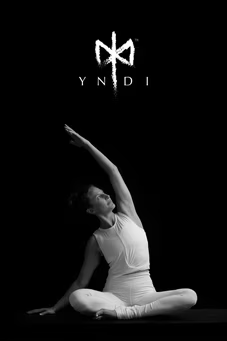


Support for PBS provided by:
Funding for ANTIQUES ROADSHOW is provided by Ancestry and American Cruise Lines. Additional funding is provided by public television viewers.


